
Dr Gokul Seshadri's latest work, Ayōdhipperumāḷ: Tamiḷ traditions on Rām katha suggests the existence of a Rama temple in Ayodhya as early as the 9th century CE, challenging conventional narratives. (Supplied)
In the backdrop of the opening of Lord Ram temple in Ayodhya on 22 January, history unveils its profound significance.
The pages go back to the Supreme Court verdict on 9 November, 2009, in the Babri Masjid — Ram Janmabhoomi case. Evidence showed a significant inscription, referred to as the Visnu Hari inscription in the apex court, within the premises of the Babri Masjid. This historical proof shed light on the construction of a Ram temple around the mid-12th century CE by the Gāhaḍavāla kings.
Concurrently, archaeological excavations conducted by the Archaeological Survey of India (ASI) at the same location unveiled a circular temple basement and a pranāla (water chute) dating back to the 10th century CE.
Fast forward to 2024, Dr Gokul Seshadri’s latest work, ‘Ayōdhipperumāḷ: Tamiḷ Traditions on Rām Katha’, emerges after 14 years of intensive research, introducing new revelations. The historian suggests the existence of a Rama temple in Ayodhya as early as the 9th century CE, challenging conventional narratives.
In an interview with South First, he delves into the lesser-known side of the story.
Excerpts follow.
What sparked your interest in researching the Rām katha traditions in Tamil Nadu?
During my PhD, I delved into Ram katha research, specifically focusing on ‘Narrative Ram katha sculptures from the Chōḷa period’.
The success of my thesis led me to expand my research to encompass Ram katha traditions across various periods. The present book represents the culmination of 14 years of dedicated research on the initial 1,600 years of Ram katha traditions in Tamil Nadu.
Can you detail the method employed for analysing epigraphic references?
I started by collecting all the references quoted by previous scholars across India and more specifically in Tamil Nadu.
Inscriptions published by Shri Vasudev Vishnu Mirasi of ASI served as primary evidence for understanding references to Rama temples in the north.
These include the Poona and Riddhapur copper plates of Prabhavati Gupta, the Kalachuri stone inscription at Rajiv Lochan temple at Rajim, and another Kalachuri stone inscription at Rewa.
For the south, I relied on prior works by Shri Kudanthai Sethuraman and Shri BV Raman.
In total, we have 36 Rama temple-related inscriptions in Tamil Nadu until the 13th century. In contrast, we have only 3 from North India until the 12th century and only a few more in the 13th century.
What were some of the significant findings that emerged during your exploration of sculptural and epigraphic references to Rama temples in the Chola, Pandya, and Tondai Mandalam regions from the 9th century CE onwards?
First and the most significant finding of this research is that the Tamil inscriptions offer the earliest epigraphic reference to independent functioning temples of Rama, in the whole of India.
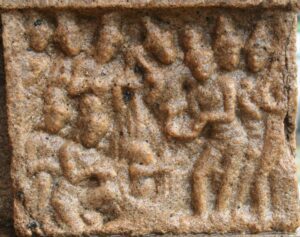
Narrative Ram katha relief from Pullamangai (Early Chōḷa period – 10th Century CE) depicting King Dasaratha receiving pinda from the divine goblin emerging out of fire from the sacrificial altar. (Supplied)
The very first inscription in this regard, is a Pāṇḍya Mārañjaḍayan towards the last quarter of the 9th century CE at the Manōnmaṇiśvara temple, Vijayanārāyaṇam (erstwhile Vijayanārāyaṇa Chaturvēdimaṅgalam) in Tirunelveli district (Reference ARE 1927:10).
These references take Rama worship back to the 9th century CE thus putting an end to the controversy surrounding Rama worship.
The second significant finding is that many of these temples (9 out of 21 temples identified in my study) call these Rama temples Tiruvayotti. Curiously, the name of a Tirtha (holy place) — Ayodhya in this case — is adopted as the name of Kshetra (temple proper). This phenomenon is not observed in numerous other Shaivite or Vaishnavite temples.
The God is also known by various names in these temples. For example, Tiruvayōṭṭip Perumāḷ, Tiruvayōṭṭi nindru arulugindra Sri Raghavan, Tiruvayōṭṭip Perumānaḍigaḷ, Rāghavadēva, Rāmadēva Perumāḷ, Lakshmī Rāghavap Perumāl, Rāghava Chakravarṭṭigaḷ and Karunākara Perumāḷ.
There is a strong sense of highlighting Ayodhya in these local temples and associating Rama as the lord of Ayodhya.
Why would a donor or king in Tamil Nadu name their temple after Ayodhya? Unless, they aimed to symbolise a direct connection to the original Ayodhya and its temple deity?
The use of Tiruvayotti references from the 10th century CE suggests that Ayodhya and its Ram temple were likely well-established. This could have potentially spearheaded the Ram bhakti movement across the country by that time.
While ASI excavations date the Ram Janmabhoomi’s circular Vimana basement to the 10th century CE, Tamil inscriptions indirectly hint at the temple’s existence possibly a century earlier.
A pasuram reference by Periyalvar in the 8th century CE, listing Ayodhya as a holy Vaishnavite city, further supports the temple’s ancient roots.
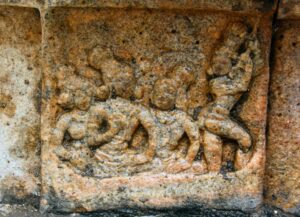
Narrative Ram katha relief from Tirumangalam (Middle Chōḷa period – 10th Century CE) depicting Rāma, Śītā and Laksmana crossing river Ganges in Guha’s boat. (Supplied)
This leads to my hypothesis that the Ram temple at Ayodhya might have stood as early as the 9th century and possibly the 8th century, gaining recognition across India.
Historical records do not mention any other Ram temple at Ayodhya apart from the one at Ram Janmabhoomi.
The third major finding has been the composition of Ram parivar which has become famous all over India.
My study suggests that this was conceived by the Chōḷa sculptors. Though there are thousands of images of Rama, Sita and Lakshman since 4th century CE, I have not come across a single instance where the Ram Darbar or Ram parivar is portrayed in a way akin to what we see in temples today.
The earliest example is from Chōḷa period in 10th century CE and these Rama parivar bronzes also happen to be the earliest in the country.
The fourth major finding is the epigraphic reference to the inclusion of Hanuman in Rama worship. This comes from Rājarāja Chōḷa’s inscription at Govindappadi (present-day Tirumalpur) (Reference ARE 1906:335). This is the earliest such reference in the country.
Which are the temples of Rama mentioned in the 36 inscriptions?
The 36 inscriptions under study highlight 21 temples of Rama. Many of these were in the Northern Tamil Nadu region (around 72%).
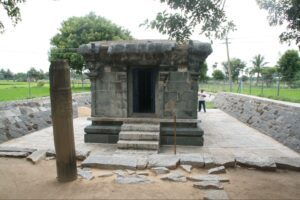
Nindraruliya Devar Temple (Konar Koil) at Tirumalpur near Kanchipuram. The temple that contains earliest reference to Hanuman worship in 10th Century CE. (Supplied)
These include the ones at Mathurantakam, Pullalur, Tirumalpur, Uttaramerur, Ukkal, Vadamadurai, Eṇṇayiram etc. In the Chōḷa country, we have inscription references coming from Amaṇguḍi, Ālanguḍi, Tirumeignanam, Tirumangalam, etc.
In Pāṇḍya country, we have Vijayanarayanam and Sēramādēvi. Unfortunately, most of these temples are extinct today. Pullalur Rāma temple is in ruins. The one at Mathuranthakam is still in worship.
Apart from epigraphic references, we should also consider Ram parivar bronzes in temples and museums which would indicate the existence of additional temples.
For example, we have Paruthiyur Rāma temple which boasts a beautiful murti of Rama from the Chōḷa ages. Another one is preserved in the Chennai Egmore Museum. We have many others.
The book explores references of Ram katha in Sangam literature and dedicates a substantial section of pages to scrutinise verses venerating Lord Rama found within the Vaishnavite and Shaivite bhakti literature.
References from Sangam literature are available in collections as early as Agananuru (No 70) and Purananuru (No 378), followed by Kalithogai (No 38) Paripadal (No 19), etc. What is significant about these references is that they are almost as old as Valmiki Rāmāyaṇa itself.
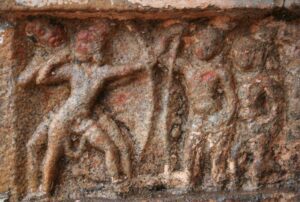
Narrative Ram katha relief from Kumbakonam (Early Chōḷa period – Late 9th Century CE) depicting Rāma (Left) learning archery from his teacher while Bharata and Laksmana watch. (Supplied)
Also, the references in this literature quote indigenous events not seen in Valmikis literature. These suggest that the story or stories should have percolated deep down the peninsula via oral and bardic traditions well before the availability of Valmiki Rāmāyaṇa.
This is followed by even more significant references in the Kavya literature such as Silappadhikaram (Madurai Kandam. Kaathais 3,4,7 & Vanji kandam. Kaathais 3,4) and Manimekalai (Kaathai 3,5, 17, 27). Here, the major development observed is the recognition of Rama as an avatar of Lord Vishnu. Both literatures repeatedly allude to the divinity of Rama.
How did these references impact Bhakti literature?
This concept of Rama as Vishnu avatar gets further enriched and elaborated in the many verses of devotional Bhakti literature, notably Vaishnavite Alwars.
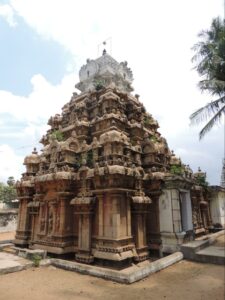
The Brahmapurisvara Temple at Pullamangai near Thanjavur, that contains narrative Ram Katha sculptures from Parāntaka Chōḷa – I period in early 10th Century CE. (Supplied)
These references are too many to quote, but we see that the trend starts with the three early Alwars from 6th Century CE. In my research, Tirumazhisai Alwar, Periyalwar, and Kulasekara Perumal stood out as poet laureates who provided the most elaborate and detailed references on Rama and Ram katha.
In the Bhakti literature, we see Rama’s divinity being exalted and his association with Lord Vishnu becomes closer over centuries. So much so that in one of the verses, Periyalvar hails Rama as one carrying the Chakra or the wheel of Vishnu (No 329).
Alongside Vaishnavite alwars, we also see Shaivite Nayanmars recognising Rama and his effort to build the temple at Rameswaram. Besides, we have numerous references in Saivite Tirumurais to Ravana who is hailed as a supreme devotee of Lord Shiva.
Can you share examples of inscriptions offering information on the consecration of standalone temples, and the placement of Lord Rama images?
Many of these temples were located in the Tondai mandalam region. These suggest that Rama bhakti had taken deep roots in prior centuries. This was the traditional Pallava heartland. Some of these temples were newly established. But, many of them were already in existence (such as the one at Vijayanarayanam).
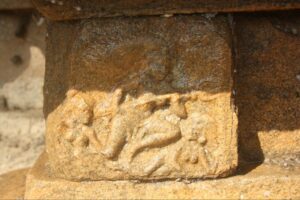
Narrative Ram katha relief from Tiruchennampoondi (Early Chōḷa period – 10th Century CE) depicting Takata attacking Rāma with her trident. (Supplied)
Parāntaka I gifted land to Madurāntakam temple for its daily worship and upkeep as tiruviḍayaṭṭam (donations to Vishnu temples) (ARE 1896:126). Other donations by individuals were mainly provided for burning lamps and daily worship. The endowment of Pārthivēndravarma’s queen at Uṭṭaramērūr was specifically for the consecration of a new Rāma temple and srībali service, archanābōgam, and other services to the lord (ARE 1898:32).
The record of Vikrama Chōḷa at Madurāntakam (ARE 1901:479) indicates provisions made to the festival and procession of Rama within the temple premises. Endowments were provided for expounding Rāmāyaṇa in temples. Two records from Puḷḷaḷūr talk about such bhāratavriṭṭi endowments to upkeep this activity (ARE 1923:55 and ARE 1923:48).
What is the cultural impact of Ram katha traditions in Tamil Nadu in influencing the broader Bharatiya tradition?
Ram katha traditions and cultural expressions flourished during the Gupta age between 4th to 6th century CE. There is a period of significant lull after the 6th century. This is where South Indian traditions pick up.
We have Chalukya sculptures, Visnukundin sculptures, and Rashtrakuta sculptures. This is followed by a significantly large Ram bhakti movement in Tamil Nadu under the Choḷa hegemony. The Tamil sculptural, epigraphic, and literary inscriptions perfectly fit a gap in the overall Bharatiya tradition of Rama devotion and worship between 9th and 13th century CE.
Another major contribution of Tamils to the whole of India is the conception of Ram parivar as murtis in temples. It is quite astonishing that this concept is now adopted all over India. But, the earliest sculptural reference comes from Tamil Nadu. Thus, it seems this was a Chōḷa conception adopted in later times all over ancient Bharath.
The book is priced at ‘400 and can be purchased here: https://pages.razorpay.com/GokulSeshadriBooks
Audio book publisher: Kathai Osai by Deepika Arun. Available on StoryTel, Spotify and other audiobook apps.

May 14, 2024

May 12, 2024

May 12, 2024

May 01, 2024

Apr 28, 2024

Apr 26, 2024